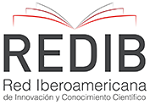Convergencia tecnológica y productividad: una perspectiva sobre la innovación en emprendimientos transfronterizos
DOI:
https://doi.org/10.15649/2346030X.4401Palabras clave:
convergencia tecnológica, productividad, innovación tecnológica, desarrollo sostenible, emprendimientoResumen
Este estudio aborda la convergencia tecnológica como un factor clave para mejorar la productividad y sostenibilidad en los emprendimientos transfronterizos. A través de una revisión bibliográfica exhaustiva y un análisis hermenéutico-dialéctico, se examinan las implicaciones filosóficas y axiológicas de la integración de tecnologías emergentes como la inteligencia artificial y el Internet de las Cosas (IoT) en los procesos empresariales. La investigación destaca cómo estas tecnologías permiten a las empresas optimizar sus operaciones, reducir costos y mejorar la eficiencia operativa, contribuyendo así a la sostenibilidad ambiental y a la reducción de la huella de carbono. Además, se subraya la importancia de la cooperación intersectorial entre gobiernos, instituciones educativas y el sector privado para cerrar la brecha tecnológica y fomentar el desarrollo inclusivo en regiones fronterizas. Las propuestas de direccionamiento estratégico presentadas en el estudio incluyen el fomento de la innovación abierta, la inversión en infraestructuras tecnológicas sostenibles, el fortalecimiento de capacidades tecnológicas y la implementación de políticas públicas que promuevan la innovación. Estas estrategias buscan maximizar el impacto positivo de la convergencia tecnológica en la productividad y sostenibilidad, creando un entorno propicio para la innovación y el desarrollo socioeconómico sostenible en regiones de frontera.
Referencias
A. Hussain, J. Jeon, y M. Rehman, “Technological convergence assessment of the smart factory using patent data and network analysis,” Sustainability, vol. 14, no. 2, 2022.
A. Stopochkin, I. Sytnik, J. Wielki, y E. Karaś, “Transformation of the concept of talent management in the era of the fourth industrial revolution as the basis for sustainable development,” Sustainability, vol. 14, no. 1, 2022.
M. Ma, S. Ke, Q. Li, y Y. Wu, "Towards carbon neutrality: a comprehensive analysis on total factor carbon productivity of the Yellow River Basin, China," Sustainability, vol. 15, no. 5, 2023.
C. Machado, K. Hodel, H. Lepikson, y B. Machado, “Distillation of essential oils: An innovative technological approach focused on productivity, quality and sustainability,” PLoS ONE, vol. 19, no. 1, 2024.
R. Bhatt, P. Singh, A. Hossain, y J. Timsina, “Rice–wheat system in the northwest Indo-Gangetic plains of South Asia: issues and technological interventions for increasing productivity and sustainability,” Paddy and Water Environment, vol. 19, no. 2, 2021.
A. Mahardhani, “The role of public policy in fostering technological innovation and sustainability,” Journal of Contemporary Administration and Management (ADMAN), vol. 18, no. 3, 2023.
K. Vodenko, G. A. Gribanov, K. Chernov, y K. Mukhina, “Russian entrepreneurship in the context of socio-economic crisis: the risks of deprofessionalization,” The Journal of Social Sciences Research, vol. 5, no. 10, pp. 1-12, 2019.
M. Kipper, E. Rodrigues, A. G. Ferrari, y B. B. Mariani, “Universities and incubators: key factors driving entrepreneurship and socioeconomic development,” Independent Journal of Management & Production, vol. 5, no. 4, pp. 947-965, 2014.
C. Kaletka, M. Markmann, y B. Pelka, “Peeling the onion. An exploration of the layers of social innovation ecosystems. Modelling a context sensitive perspective on driving and hindering factors for social innovation,” European Public & Social Innovation Review, vol. 1, no. 2, pp. 1-11, 2017.
A. Tăbîrcă, O. Ivan, y Decembrie, “Relationship between corporate social responsibility and entrepreneurship - evidence from romanian entrepreneurs,” International Conference Innovative Business Management & Global Entrepreneurship (IBMAGE 2020), vol. 1, no. 1, pp. 112-124, 2020.
S. A. Haughton y C. Sewell Lewis. “Colombia-Venezuela Border: Securitisation of migration and Venezuela’s political crisis”. Oasis, 40, pp. 129-158, 2024.
M.A. Cuberos, N. Albornoz-Arias, C. Ramírez-Martínez y A.K. Santafé-Rojas. “Integration of unemployed venezuelan immigrant women in Colombia,” Social Sciences, vol. 13, no. 5, pp. 2-23, 2024.
M.T. Miah, Z. Lakner y M. Fekete-Farkas. “Addressing poverty through social entrepreneurship for sustainable development: a comprehensive bibliometric analysis,” Administrative Sciences, vol. 14, no. 1, pp. 2-31, 2024.
J.D. Hernández-Albarracín, M. Ramírez-Lindarte y A. Bravo, A. “Hacia un nuevo lugar de enunciación: aportes intersubjetivos sobre la calidad de la educación en norte de Santander. Una perspectiva desde la teoría fundamentada,” Análisis Político, vol. 36, no. 107, pp. 89–108, 2024.
Empresarios por la Educación. Repensar la educación. Rutas para la transformación educativa. Colombia: Ariel, 2022.
A. Abulibdeh, E. Zaidan, y R. Abulibdeh, “Navigating the confluence of artificial intelligence and education for sustainable development in the era of industry 4.0: Challenges, opportunities, and ethical dimensions,” Journal of Cleaner Production, vol. 437, 2024.
Organización de las Naciones Unidas. “Global cooperation in science, technology and innovation for development,” UNCTAD, Geneva, E/CN.16/2024/3, Feb. 5, 2024. [Online]. Available: https://bit.ly/3ybYTYc.
R. Rosário, C. Varum, y A. Botelho, “The role of public incentives in promoting innovation: an analysis of recurrently supported companies,” Economies, vol. 12, no. 6, pp. 148, 2024.
H. Etemad. “Towards an integrated and longitudinal life-cycle framework of international entrepreneurship: Exploring entrepreneurial orientation, capabilities, and network advantages overcoming barriers to internationalization,” Journal of International Entrepreneurship, vol. 20, pp. 503-536, 2022.
H. W. Chesbrough. Open innovation: the new imperative for creating and profiting from technology. Boston: Harvard Business School Press, 2006.
M. E. Porter. Competitive strategy: techniques for analyzing industries and competitors. Reino Unido: Free Press, 1980.
E. Ries. The lean startup: how today's entrepreneurs use continuous innovation to create radically successful businesses. Reino Unido: Crown, 2011.
H. W. Chesbrough, W. Vanhaverbeke, y J. West. Open innovation: researching a new paradigm. New York: Oxford University Press, 2008.
S. Ahn, K.-S. Kim, y K.-H. Lee, “Technological capabilities, entrepreneurship and innovation of technology-based start-ups: the resource-based view,” Journal of Open Innovation: Technology, Market, and Complexity, vol. 8, pp. 156, 2022.
B. Elzein, “Tiny tech, big impact: How nanotechnology is driving SDGs progress,” Heliyon, vol. 10, no. 10, p. e31393, 2024.
D. Helbing y M. Ienca. “Why converging technologies need converging international regulation,” Ethics and Information Technology, vol. 26, pp. 15, 2024.
R. Grant. “The resource-based theory of competitive advantage: Implications for strategy formulation,” California Management Review, vol. 33, no. 3, pp. 114-135, 1991.
S. Cooper, V. Pereira, D. Vrontis, y Y. Liu. “Extending the resource and knowledge-based view: Insights from new contexts of analysis,” Journal of Business Research, vol. 156, p. 113523, 2023.
A. Garrido-Moreno, R. Martín-Rojas, y V. J. García-Morales. “The key role of innovation and organizational resilience in improving business performance: A mixed-methods approach,” International Journal of Information Management, vol. 77, pp. 102777, 2024.
A. Salamzadeh, M. Hadizadeh, N. Rastgoo, M. M. Rahman, y S. Radfard. “Sustainability-oriented innovation foresight in international new technology-based firms,” Sustainability, vol. 14, no. 20, pp. 13501, 2022.
R. Freeman, J. Harrison, y A. Wicks. Managing for stakeholders: survival, reputation, and success, Yale University Press, 2007.
D. Teece. “Business models, business strategy and innovation,” Long Range Planning, vol. 43, no. 2-3, pp. 172-194, 2010.
P. Drucker, Innovation and entrepreneurship. Reino Unido: Taylor & Francis, 2014.
K. Eisenhardt y D. Sull. “Strategy as simple rules,” Harvard Business Review, vol. 79, no. 1, pp. 107-116, 2001.
C. Prahalad y V. Ramaswamy, “Co-creation experiences: The next practice in value creation,” Journal of Interactive Marketing, vol. 18, no. 3, pp. 5-14, 2004.
M. Porter. “The five competitive forces that shape strategy,” Harvard Business Review, vol. 86, no. 1, pp. 78-93, 2008.
J. Margolis y J. Walsh. “Misery loves companies: rethinking social initiatives by business,” Administrative Science Quarterly, vol. 48, no. 2, pp. 268-305, 2003.
M. Porter y M. Kramer. “Creating shared value,” Harvard Business Review, vol. 89, no. 1-2, pp. 62-77, 2011.
P. Romer. “Endogenous technological change,” Journal of Political Economy, vol. 98, no. 5, pp. S71-S102, 1990.
R. Adams, S. Jeanrenaud, J. Bessant, D. Denyer, y P. Overy. “Sustainability-oriented Innovation: A Systematic Review,” International Journal of Management Reviews, vol. 18, no. 2, pp. 180-205, 2016.
Deloitte. “The fourth industrial revolution is here—Are you ready?”, 2018. [En línea]. Disponible: https://www2.deloitte.com. [Accedido: 25-Jul-2024].
J. Elkington. Cannibals with forks: The triple bottom line of 21st century business. Reino Unido: New Society Publishers, 1998.
L. Huston y N. Sakkab. “Connect and develop: Inside Procter & Gamble's new model for innovation,” Harvard Business Review, vol. 84, no. 3, pp. 58-66, 2006.
H. Chesbrough. “The future of open innovation: The future of open innovation is more extensive, more collaborative, and more engaged with a wider variety of participants,” Research-Technology Management, vol. 60, no. 1, pp. 35-38, 2017.
M. Dabić, T. Daim, M. Bogers, y A. Mention. “The limits of open innovation: Failures, risks, and costs in open innovation practice and theory,” Technovation, vol. 117, 2023.
H. W. Chesbrough y A. Garman. “How open innovation can help you cope in lean times,” Harvard Business Review, vol. 87, no. 12, pp. 68-76, 2009.
M. Bogers, H. W. Chesbrough, y C. Moedas. “Open innovation: research, practices, and policies,” California Management Review, vol. 60, no. 2, pp. 5-16, 2018.
H.-G. Gadamer. Truth and method. New York: Continuum, 2004.
P. Ricoeur. Hermeneutics and the human sciences, J. B. Thompson, Ed. Cambridge: Cambridge University Press, 1981.
J. W. Creswell. Qualitative inquiry and research design: choosing among five approaches. CA: SAGE Publications, 2013.
N. Denzin y Y. Lincoln. The SAGE handbook of qualitative research. CA: SAGE Publications, 2011.
R. K. Yin. Case study research: design and methods. CA: SAGE Publications, 2014.
J. Maxwell. Qualitative research design: an interactive approach. CA: SAGE Publications, 2013.
M. J. Grant y A. Booth. "A typology of reviews: an analysis of 14 review types and associated methodologies," Health Information & Libraries Journal, vol. 26, no. 2, pp. 91-108, 2009.
D. Gough, S. Oliver, y J. Thomas. An introduction to systematic reviews. London: SAGE Publications, 2017.
P. Drucker. Innovation and entrepreneurship. Reino Unido: Taylor & Francis, 2014.
G. Choi. “Determinants of target location selection for acquirers in the manufacturing sector: Pollution intensity, policy enforcement, and civic environmentalism,” Journal of Business Research, vol. 146, pp. 308-324, 2022.
S. Mondal, F. Faruk, D. Rajbongshi, M. Efaz, y M. Islam. “GEECO: Green data centers for energy optimization and carbon footprint reduction,” Sustainability, vol. 15, no. 21, p. 15249, 2023.
D. Olawade, O. Wada, A. David-Olawade, O. Fapohunda, A. Ige, y J. Ling, “Artificial intelligence potential for net zero sustainability: current evidence and prospects,” Next Sustainability, vol. 4, p. 100041, 2024.
B.-A. Schuelke-Leech. “Disruptive technologies for a green new deal,” Current Opinion in Environmental Science & Health, vol. 21, p. 100245, 2021.
S. A. Frick y A. Rodríguez-Pose. “What draws investment to special economic zones? Lessons from developing countries,” Regional Studies, vol. 57, no. 11, pp. 2136–2147, 2023.
Descargas
Publicado
Cómo citar
Número
Sección
Altmetrics
Descargas
Licencia
Derechos de autor 2024 AiBi Revista de Investigación, Administración e Ingeniería

Esta obra está bajo una licencia internacional Creative Commons Atribución 4.0.
La revista ofrece acceso abierto bajo una Licencia Creative Commons Attibution License

Esta obra está bajo una licencia Creative Commons Attribution (CC BY 4.0).










